Intel Core 2 Duo E6300 & E6400: Tremendous Value Through Overclocking
by Anand Lal Shimpi on July 26, 2006 8:17 AM EST- Posted in
- CPUs
Application Performance using SYSMark 2004 SE
We'll kick off our look at general application performance with SYSMark 2004 SE and as always, we'll look at the overall score as well as the scores in each of the two suites - Internet Content Creation and Office productivity.
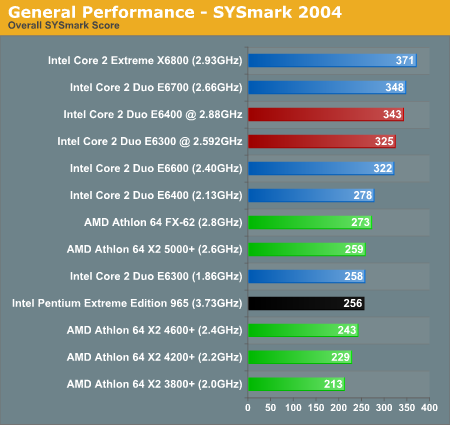
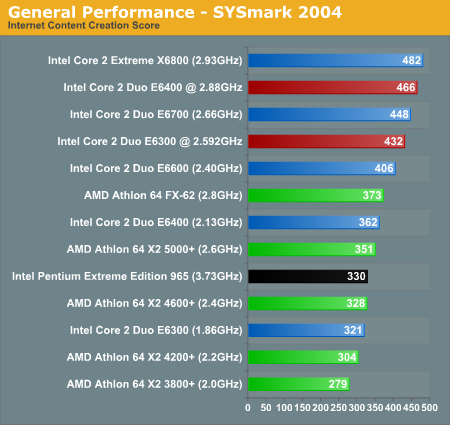
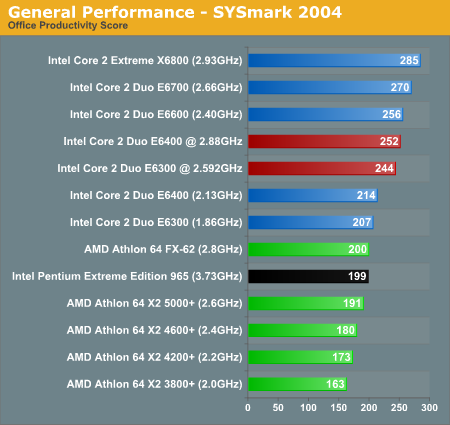
The applications tested by SYSmark 2004 cover the vast majority of the modern computing spectrum. Everything from multimedia to office to multitasking performance is included, and while not every application will show a substantial performance increase with a faster processor, the overall performance spread among the tested CPUs is almost 75%. If you routinely do a lot of computationally intensive work on your system (surfing the web and writing email generally don't count), there's no question that you will see a substantial difference between the fastest and slowest systems we're testing.
Our first look at the E6300/E6400 with overclocking generates some interesting results. There has been speculation that one of the reasons Core 2 Duo chips perform so well is that they have so much L2 cache. Dropping from 4 MB to 2 MB of cache does hurt performance a bit, but with a little bit of overclocking both of our budget Core 2 Duo chips perform very well. The net loss appears to be about 200 MHz, so the 2.88 GHz E6400 roughly equals the 2.66 GHz E6700, and the 2.59 GHz E6300 roughly matches the 2.4 GHz E6600. Drilling down into the individual benchmark results for SYSmark 2004, the impact of the reduced cache is more apparent in Office Productivity applications than it is in the Internet Content Creation results, but the 2MB Core 2 chips preform respectably regardless of the application being tested. Perhaps a Core 2 with 1MB or less of L2 wouldn't perform all that well, but since those parts don't exist there's no reason to worry about hypothetical bottlenecks right now.
Switching over to the AMD versus Intel comparisons, the E6300 and E6400 already compete very well, and once we throw in overclocking they are basically out of reach of any of the AM2 processors -- with or without overclocking. In overall score, the overclocked E6300 is almost 20% faster than the FX-62. A 20% overclock of the FX-62 (3.33 GHz) might close the gap, but it would certainly require more than stock air cooling, and it doesn't change the fact that we are able to get extremely good performance out of Intel's $180-$220 parts.
The individual SYSMark 2004 SE scores are graphed below if you're interested; the data is used in calculating the overall scores we've already discussed above:
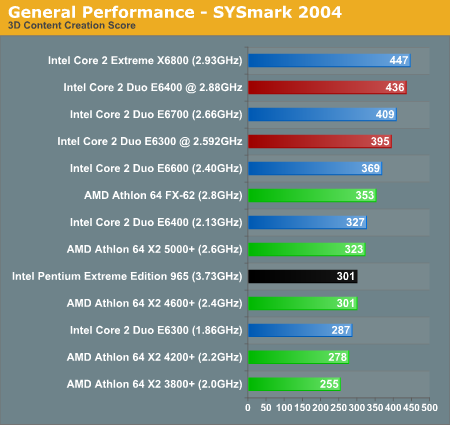
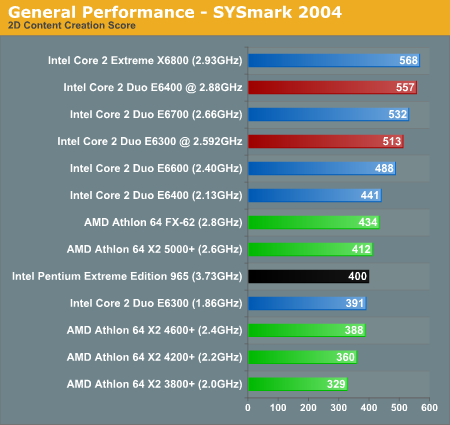

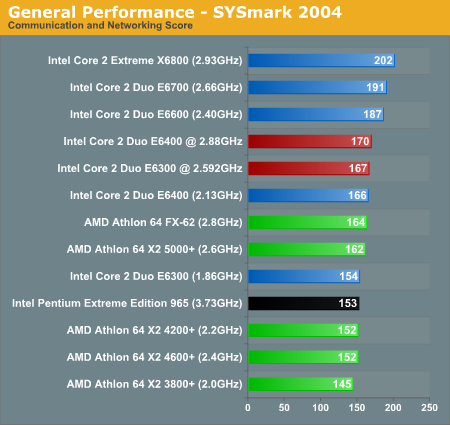
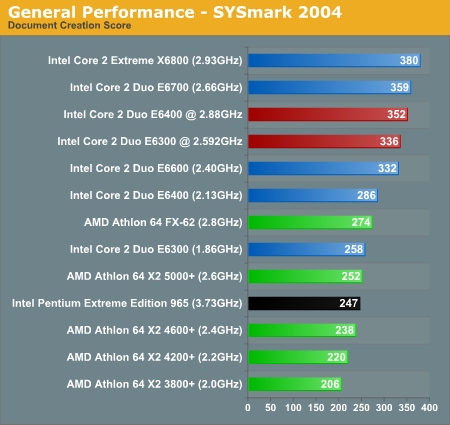
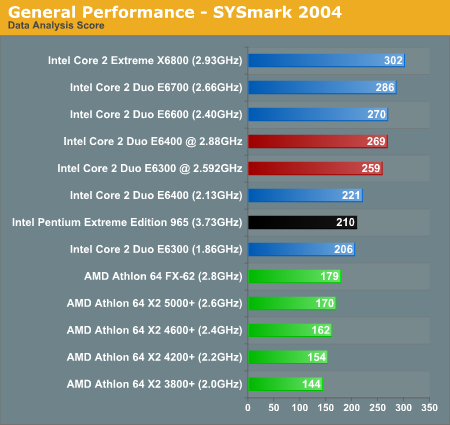










137 Comments
View All Comments
BPB - Wednesday, July 26, 2006 - link
When are the 5000+'s hitting the shelves?kmmatney - Wednesday, July 26, 2006 - link
Great article - this is exactly what I've been looking for, From what get out of it, if the user does not overclock, then the Conroe and X2's are about equal, especially when you take motherboard pricing into account. For users who overclock, then the Conroe takes over. In the end, I think the final bang/buck will depend on how cheaper motherboards perform for the Conroe.I don't see why people are complaining about not showing overclocks for the 3800+ - there is enough information there to figure out what the poerformance would be.
Sunrise089 - Wednesday, July 26, 2006 - link
I enjoyed this article, and suppose everyone at AT has been working hard to give us all this Conroe content quickly, and any omission made is far more likely to stem from simple hurried forgetfullness than any sort of real bias. Still, if the question is budget-conscious overclocking, or even really any sort of budget (so anything that isn't an X6800 or FX-62) you guys are really mis-representing the comparisons.To an overclocker a E6300 has to be faster than the X2 that costs the same AFTER MOTHERBOARD cost is taken into account. That meens if in order to get the kind of performance the Conroe parts achieve in this article they had to have a $250 motherboard, that needs to be factored in much more than just a token "keep in mind Intel motherboards cost more" type of line. Thus the true comparisons are:
E6300 - X2 5000+
E6400 - X2 5000+ and an aftermarket cooler
E6600 - X2 5000+, cooler, and $100+ left over.
E6700 - No overclocker would choose an E6700.
This sort of comparison yeilds a non-gaming performance/dollar ratio that is so much more important than the much more asked for performance/watt comparisons I'm sure you guys will be giving us in the future. Obviousely for games the GPU matters most, and once again, AMD has an advantage since their lower cost (with motherboard purchase) meens you can move up for free to the next level of GPU. The best and most fair comparison you guys could (and should!) be making is to compare total system costs at everything from $500 (I think that's the cheapest total price from a Conroe CPU, cheaper motherboard, and decent video card), all the way up to $1,400+ (E6600, cooler, overclocking motherboard, 2 X1900XTs in Crossfire).
Do this and I seriousely doubt AMD performance would look that bad.
You guys have to know this, since Anand does point out the higher cost of the Intel motherboards. But to point out the increased cost and then completely ignore it and make specific comparisions to Intel vs AMD chips based on cost borders on deliberately decietful. We all know eventually these prices will stabilize, and at that point I will be trading my Opteron up to an E6600, but right now the price comparisons you make are simply not valid.
Finally, everything I said above hides two intangables that also go strongly in AMD's favor that you seem to be ignoring: In all likelyhood Conroe will be selling for more than Intel's set prices (X2s might be as well, but almost certainly they will be closer to MSRP), and the X2s are much more likely to have consistent overclocking results with much less risk of "engineering samples" tested by you guys that do not match the performance we will be able to purchase ourselves.
redbone75 - Wednesday, July 26, 2006 - link
Seems almost like a convincing argument here, but you kind of defeat it yourself. You say that budget conscious overclockers would have to buy a $250+ motherboard if they want to achieve these overclocks, but if you had read through the threads you would probably have noted that Anand says the Gigabyte DS3, a 965-based board, sells for around $140 and overclocks just as well as the Asus board, but without Crossfire. I'm pretty sure a budget conscious overclocker would be looking to that board first. Also, how many budget oriented system builders really bother with crossfire? The savings would be better put towards a single higher-end card. Not only that, not all overclockers do so for gaming. I do a lot of video encoding and the overclocking ability of the E6400 and E6300 definitely has my attention. I think the whole point of the article was budget overclocking anyway, and for the X2 3800+ (AMD should really drop the '+' from their processor names now, I think) to have been relegated to budget status is quite telling. No, wait, the performance is quite telling.I hate throwing around labels like "fanboy" and "whiner," but when people keep reaching for excuses about why one processor does better than another instead of rejoicing that there is a better performing part available, then what exactly do you call them? Anandtech has not recommended an Intel processor for what, three years now, so for you all to start saying that their on Intel's payroll and such is rather disrespectful. Go join an AMD fans forum if this site's articles make you so upset.
Sunrise089 - Wednesday, July 26, 2006 - link
Look - I want to be very up-front about this:Conroe is better than X2. It's faster, cooler, and it overclocks better. On the high-end it is absolutely the smart choice.
It's also much more expensive than it appears, something the article does not talk enough about.
I was under the impression that the cheaper Conroe mothervboards did not overclock as well. If they do then it does damage my aruegment. Still, AMD (though slower overall) has a big advantage in that the various X2s' overclocks are much more tightly clustered than the Conroe parts. Cache seems to matter more for Conroe as well. So if we're comparing equal cost overclocking performance a X2 3800+ will perform much closer to a X2 5000+ on air than a E6300 and an E6700 (or at least that's how I read the graphs).
dev0lution - Wednesday, July 26, 2006 - link
Maybe I'm missing something, since your whole upgrade argument was based on an imagined price gap that a Conroe purchaser would face. The second page of the article posted prices for AM2 and Conroe parts, which were generally in-line with the comparisons made. The article compares the nearest equivalent part from each side versus it's performance.
I'm not talking K8L timeframe, which is so far off not even engineering samples have been reviewed. I'm talking in the next month, which when a product hasn't even officially launched yet is pretty dang close to the present. ZZF already had the E6300 posted today for $199 which is a $16 price premium over the price posted in the article. This is for a part that "is also faster than the 4200+ and the 4600+ in some benchmarks" at stock speeds.
If you're going value then you're not worried about SLI/Crossfire boards, which leaves you with single GPU boards, which as the article mentions... "quite a few of the P965 motherboards that can also overclock the budget Core 2 chips to reasonable levels, with prices hovering much closer to $140." Now we're in AM2 platform price range, even though this is the week of launch and most of the boards available are performance priced parts.
The myth that there's this big price differential between the two, even though there's a premium on the Intel platforms since it technically hasn't even launched yet, is misleading.
I believe that was your gripe with the article to begin with?
Yields, fab capacity, product margin and chips per wafer are a whole 'nother topic. To summarize 65nm > 90nm
The original posts sounded fanboy-ish, so don't get mad if someone paints you with that brush...
Sunrise089 - Wednesday, July 26, 2006 - link
You make a number of good points.Still, if we assume that not much gouging will take place and that AT's results with these chips are typical, I still think I have a valid point, even if it less significant than I thought.
If we start with the comparison of an X6800 and an FX-62, obviousely the Conroe is far faster, overclocked or not. Moving downmarket but still overclocking, the AMD parts seem to loose reletively little performance, with an X2 3800+ will probably clocking to within 15% of the FX-62 when both are overclocked, and the cache difference seeming to not effect performance to a huge degree. With Conroe however, moving from the X6800 downward really does seem to limit performance and maximum overclocks, making the various parts in the product line much less interchangeable when overclocking compared to the AMD line. When you further reduce overclocks due to a cheaper Intel motherboard, even if dual-GPU isn't necessary, that may still meen the AMD parts perform very favoribly dollar for dollar, at least at today's listed prices.
I think my mistake was transplaniting my opinions onto the market as a whole. I will strongly factor in overclocking performance into my future buying decisions, yet I also will require the ability to go SLI or Crossfire. I sort of assumed that would be a common view, and therefore paid less attention to the cheaper Intel chipset offerings.
dev0lution - Wednesday, July 26, 2006 - link
You might have a point if you could get a 5000+ for socket 939. You can't, so you're out almost as much for DDR2 and a new AM2 motherboard. Cost difference will be negligible once more Core 2 Duo boards are out and availability is better a few weeks after tomorrow's launch.And I do like how the AMD fanboy's have forgotten that launch is tomorrow, not last week when the Conroe reviews started dropping.
It's kind of sad that so many people who used to tout how buying a 3000+ or 3200+ and overclocking would get you performance better than any P4 just can't accept that a Conroe E6300 or E6400 can kick the pants out of half of AMD's lineup mildly overclocked. Intel and AMD don't care about you. Really. They're just trying to sell more product.
Thx to Anandtech for the article. I'm still trying to figure out whether to move up to a 4800+ on S939 and use the extra cash for more memory and a better GPU, or whether I should beg for a demo samples for the Conroe parts =)
Sunrise089 - Wednesday, July 26, 2006 - link
I'm perfectly willing to stand corrected. Are decent overclocking AM2 motherboards $250 as well? I wasn't aware of it if they are.Really though, your s939 point is irrelevent. If the user already has s939 then obviousely anyone who considers gaming important knows that a Conroe upgrade would be a horrible deal. It would be much smarter to use the $$$ on a GPU upgrade. The tired arguement is that they could sell the old parts, but the terrible depreciation rarely makes that the best option. You seem to be falling into the same trap the fanboys you wish to criticise make - talking about the future and ignoring the present. I'm sure Intel motherboards will become cheaper, and I'm also sure K8L will increase AMD's performance envelope. My comments however were directed at the article that arrived today. I made no comment last week in the launch article. Today though, Anandtech has chosen to release an overclocking article based around the concept of value. As of today their numbers are badly flawed. When the numbers change in the future, that's the time to bring it up in a weekly CPU or motherboard price guide.
"...a Conroe E6300 or E6400 can kick the pants out of half of AMD's lineup mildly overclocked" - they should, since they cost more than half of AMD's lineup, and more than almost all of it after motherboard costs are factored in.
"They're just trying to sell more product." - Profits are actually the key, not sales. Otherwise the new Celeron launch would be the most important news of the year.
I am hardly a fanboy. My PC processors have been: Pentium, K6-2, Athlon, Northwood, Opteron, and soon to come a Conroe. In both my above comments I mentioned how I would buy a Conroe soon. In the second comment I mentioned how Intel motherboard prices would drop in the future. In the first comment I stated outright that Conroe is faster clock-for-clock, and it goes without saying that Conroe will hit higher overall clock speeds than and AMD part. My point still remains though: Conroe is very possibly not faster dollar for dollar than AMD until you go past the 5000+ level, where basically AMD no longer fields products (noone buys FXs).
yacoub - Wednesday, July 26, 2006 - link
You do have a point that most overclockers are money-conscious/bang-for-the-buck folks by nature and would very much consider the overall price and thus motherboards would be a big part of that since their costs keep going up with each new chipset it seems.